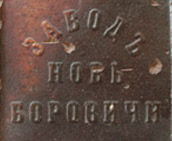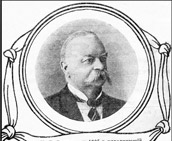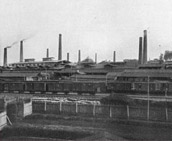Joint Stock Company "Borovichi Refractories Plant" is the oldest refractory enterprise in the country, the birth-place of Russian refractories. The basis of its development was the richest reserves of refractory clay of Borovichi-Lyubytinsk deposits in Novgorod region. In 1857 E. Nobel built the first specialized plant "for production of fire enduring bricks from locally available fire enduring clay” in a small country town Borovichi, Novgorod province. A gradual changeover from the handicraft ceramic trade to factory production started. Information on getting industrial supplies of refractory products from Borovichi is referred to the end of the 70's, which was much contributed by the construction of Borovichi-Uglovka railway, connecting the city with Nicholaevsk railway.
In 1857 E. Nobel built the first specialized plant "for production of fire enduring bricks from locally available fire enduring clay” in a small country town Borovichi, Novgorod province. A gradual changeover from the handicraft ceramic trade to factory production started. Information on getting industrial supplies of refractory products from Borovichi is referred to the end of the 70's, which was much contributed by the construction of Borovichi-Uglovka railway, connecting the city with Nicholaevsk railway.
 In the second half of the nineteenth century large factories for the production of refractory, acid, sewer products from local clays were built. Among them are "Pirogranit" ("Terracotta"), K. Wachter’s Plant, TOPGI plant, "Nov’". In Borovichi a major industrial center for the production of fireclay refractories, which are gradually replacing imports from the Russian market, was constructed. The protectionist policy of the government contributed to this by imposing a duty on imported refractories (in 1886 and 1891).
In the second half of the nineteenth century large factories for the production of refractory, acid, sewer products from local clays were built. Among them are "Pirogranit" ("Terracotta"), K. Wachter’s Plant, TOPGI plant, "Nov’". In Borovichi a major industrial center for the production of fireclay refractories, which are gradually replacing imports from the Russian market, was constructed. The protectionist policy of the government contributed to this by imposing a duty on imported refractories (in 1886 and 1891).
 Undisputed leader, "the king of refractories" was Konstantin Wachter, a St. Petersburg’s industrialist and "Borovichi plant for production of refractory, acid products and sewage pipes" founded by him in 1880, which in 16 years was reformed in the joint stock company. K. Wachter’s company united the best Borovichi Refractory Plants, the plant in Voronezh province and several mines, becoming the largest company in the industry (production of refractory products was 16.5% of the Russian ones).
Undisputed leader, "the king of refractories" was Konstantin Wachter, a St. Petersburg’s industrialist and "Borovichi plant for production of refractory, acid products and sewage pipes" founded by him in 1880, which in 16 years was reformed in the joint stock company. K. Wachter’s company united the best Borovichi Refractory Plants, the plant in Voronezh province and several mines, becoming the largest company in the industry (production of refractory products was 16.5% of the Russian ones).
 Products were supplied to steelworks of St. Petersburg, Sormovo plantы in Nizhny Novgorod, Bryansk steel-casting foundry, Tula ammunition plant and many other plants, railways, marine department. The quality of products was as good as the quality of European products. From 1891 to 1893 plants in Borovichi received a favourable review on their products from 41 customers. In 1889 the products of "Pirogranit” plant was awarded the Silver Medal at the World Industrial Exhibition in Paris. In 1895 fireclay bricks from Borovichi were awarded the Gold Medal of the National Academy of Agriculture, Manufactures and Commerce in Paris. During the first World War, K. Wachter’s Company worked almost entirely for the Russian defense industry, increasing by six times the release of acid-resistant products for military factories, including ceramic fans and pumps, not manufactured earlier at Russian plants.
Products were supplied to steelworks of St. Petersburg, Sormovo plantы in Nizhny Novgorod, Bryansk steel-casting foundry, Tula ammunition plant and many other plants, railways, marine department. The quality of products was as good as the quality of European products. From 1891 to 1893 plants in Borovichi received a favourable review on their products from 41 customers. In 1889 the products of "Pirogranit” plant was awarded the Silver Medal at the World Industrial Exhibition in Paris. In 1895 fireclay bricks from Borovichi were awarded the Gold Medal of the National Academy of Agriculture, Manufactures and Commerce in Paris. During the first World War, K. Wachter’s Company worked almost entirely for the Russian defense industry, increasing by six times the release of acid-resistant products for military factories, including ceramic fans and pumps, not manufactured earlier at Russian plants. Revolution and civil war almost completely stopped production of refractories in Borovichi. In 1919 Borovichi factories and mines were nationalized, restored at an accelerated tempo and in 1922 merged into the "Borkombinat". From 1926 to 1931 refractory plants and mines of Voronezh province were under its command.
Revolution and civil war almost completely stopped production of refractories in Borovichi. In 1919 Borovichi factories and mines were nationalized, restored at an accelerated tempo and in 1922 merged into the "Borkombinat". From 1926 to 1931 refractory plants and mines of Voronezh province were under its command.
In two pre-war five-year plans in the Soviet Union a powerful refractory industry was created. "Krasny Keramik" plant (as it was named from 1931 to 1957) was "the main basis for providing the Soviet industry with the major refractories, including the shaped ones" and produced 65% of all the fire clay products of "Refractories" Trust providing the industry not only in Leningrad and all the North region, but partially the central industrial area and Ural.
Borovichi refractories were used for construction of giant blast-furnaces of Kuznetsk and Magnitogorsk metallurgical plants. The workers in Borovichi were the first in the country who began developing semi-dry method of products compression, the first who exported domestic refractories. The own workers-inventors were brought-up: M. A. Samarin and Ya. G. Panteleyev. The plant became a "talent foundry" for young refractory industry. In 1939 the government awarded the staff of the oldest industry enterprise with the Order of the Red Banner of Labour for the contribution to the industrialization of the country.
In 1939 the government awarded the staff of the oldest industry enterprise with the Order of the Red Banner of Labour for the contribution to the industrialization of the country.
When the Great Patriotic War began the Novgorod region was the scene for fierce fighting, and the Plant being in the immediate battle area, experienced a massive evacuation of the main process, energy equipment and personnel to the Urals: in Bogdanovich, Pervouralsk, Sukhoi Log, Satka, Nizhny Tagil. Together with the Ural’s workers, Borovichi’s workers built new workshops, installed equipment, mastered the production of new products for the defense industry. Production of refractories, which went on in Borovichi over a hundred years, suddenly stopped. The central power plant continued operation providing factories and hospitals with electricity. The central engineering workshops beame a military factory and fulfilled defense orders of Leningrad, Volkhov and the North-Western Fronts. Over three thousand refractory employees went to the front.
Labor deed was the recovery of refractories production in Borovichi, which started in May 1942 under the State Defence Committee decision. Process equipment was newly created, teams of plants, mines were staffed. In 1943, the plant produced 95,000 tons of refractories.
Heroic work of the team in the years of war was awarded the Order of the Patriotic War of the 1st class by the country government (1985).
After the war a radical reconstruction and technical re-equipment began. In 1952 the first in the country short tunnel kiln designed for baking domestic products (shop 2) was commenced, two new shops for baking clay in rotary kilns to produce fire clay were built (in 1957 and 1967). The Plant shops were switched to progressive semi-dry method of products compression. In 1962 gasification of the Plant started.
The shops were provided with the own significant raw materials base. In 1979 maximum amount – 967 thousand tons of refractory clay – was extracted.
Refractory men in Borovichi initiated many patriotic initiatives, competed in their work with the staff of the Ural plant "Magnesite" Chasov-Yarsk and Semiluki refractory plants. The talented inventor I.V. Spivak designed 14 presses for the manufacture of siphon products operated in many factories of the country.
In 1957 the RSFSR government awarded diplomas to the Plant and a large group of refractory men for achievements in the development of refractory industry. In 1967 the team of the Plant was the only refractory companies’ team who was awarded a commemorative banner of the Central Committee, the Presidium of the Supreme Soviet of the USSR and the All-Union Central Trade Union Council.
In 1970 the Plant was named after V. I. Lenin. In 1967 the design task for the expansion and reconstruction of the Borovichi Refractories Plant was approved by the Decree of the USSR Council of Ministers. The most important was the object of a new steel foundry with modern equipment, flexible process flow sheet, which allowed implementation of new production lines. The scale of construction required enormous effort from the whole team.
Since 1980 to 1983 three construction stages were commenced and old buildings and shops were closed (1, 5, 8). Now the steel foundry concentrates the major refractory manufacturing. Products for all process stages of iron industry are produced for blast furnaces, coke ovens, air heaters of blast furnaces.
 Mining of own kaolins is performed by opencast method in the Okladnevo and Malinovets cast mines.
Mining of own kaolins is performed by opencast method in the Okladnevo and Malinovets cast mines.
In 1992 the State-owned enterprise Borovichi Refractories Plant was reformed to a joint stock company – JSC «BRP». In the past twenty years passed since that time the development of modern highly refractory materials and development of new markets had continued. Following the age-old traditions of quality, the Plant was among the first in 1994, which began a voluntary certification of its products and had been working since then in accordance with the strict requirements of ISO 9000.
Among the consumers of the Plant’s products are enterprises of iron metallurgy, construction materials, glass, cement, whiteware, pulp and paper and other industries. The most successful investment project of this period was the development of the granulated powders – proppants – for the oil and gas industry. "The fruit of efforts, work and inspiration of the team" was the commencement of the first phase in 1998. Refractory men in Borovichi were the first in Russia who mastered the production of proppants, and received the certificate of the American Institute of Oil and Gas for their compliance with the international standard API Q1. Since 2000 JSC «BRP» is a member of the International Association of proppants manufacturers. Counting on the commissioning of the newest and best, the Plant has built up its own research center – the Centre of Improvements in Technology and Production, trained and continues to train young talented engineers in higher education institutions, providing with a stipend and interesting and promising work. JSC “BRP” follows active social policy, supports veterans and youth, replenish the city treasury, participates in charitable activities for the benefit of Borovichi.
Counting on the commissioning of the newest and best, the Plant has built up its own research center – the Centre of Improvements in Technology and Production, trained and continues to train young talented engineers in higher education institutions, providing with a stipend and interesting and promising work. JSC “BRP” follows active social policy, supports veterans and youth, replenish the city treasury, participates in charitable activities for the benefit of Borovichi.
 The Plant has many significant awards, both national and international ones. Since 2000 JSC «BRP» has been the winner of the contest "1000 Best Russian Enterprises and Organizations". In 2007 the team earned a honorific mention from the President Vladimir V. Putin for a major contribution to the development of domestic industry. Active social policy of the Board of Directors was also awarded. The plant and the city build their future together, they have a long and successful way.
The Plant has many significant awards, both national and international ones. Since 2000 JSC «BRP» has been the winner of the contest "1000 Best Russian Enterprises and Organizations". In 2007 the team earned a honorific mention from the President Vladimir V. Putin for a major contribution to the development of domestic industry. Active social policy of the Board of Directors was also awarded. The plant and the city build their future together, they have a long and successful way.




